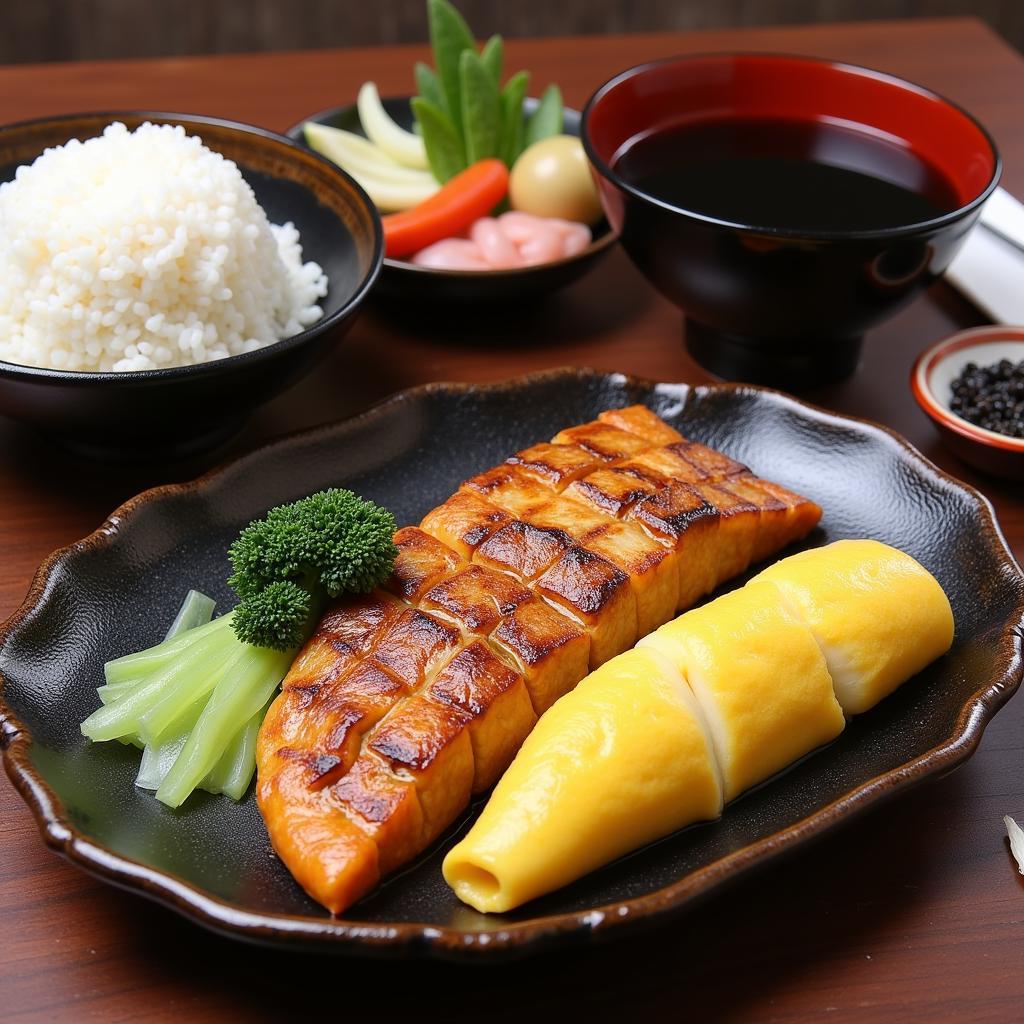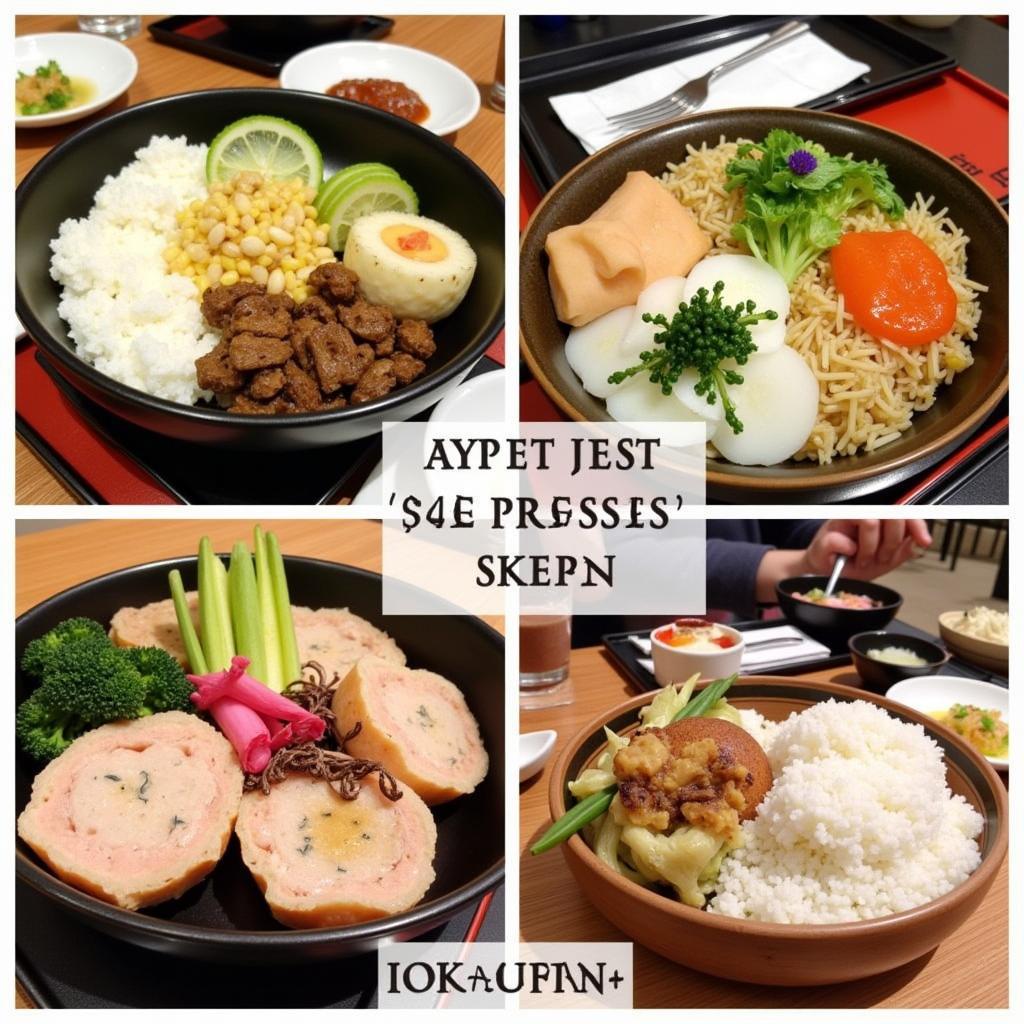Japanese breakfasts are a world away from sugary cereals and quick toast. They are a delicate balance of flavors, textures, and nutrients, designed to kickstart your day with a healthy and satisfying meal. From grilled fish and fluffy rice to savory miso soup and pickled vegetables, exploring Japanese breakfast foods is a culinary adventure in itself. Let’s dive into this fascinating world and discover the unique components that make up a traditional Japanese breakfast.
Key Components of a Typical Japanese Breakfast
A traditional Japanese breakfast, or asagohan, is a carefully curated ensemble of dishes, each playing a vital role in providing a balanced and nutritious start to the day. While variations exist based on region and personal preference, certain elements remain constant.
- Gohan (Steamed Rice): The foundation of most Japanese meals, including breakfast. This short-grain rice is fluffy and slightly sticky, offering a comforting and filling base.
- Miso Soup: A warm and savory soup made with dashi (a seaweed and bonito flake broth) and fermented soybean paste (miso). It’s packed with umami and provides a comforting start to the day.
- Protein: Grilled fish, such as salmon or mackerel, is a popular choice. Tamagoyaki (rolled omelet) or a small portion of tofu can also be included.
- Tsukemono (Pickled Vegetables): These add a salty, tangy, and slightly sour counterpoint to the other dishes, aiding digestion and stimulating the appetite. Common varieties include pickled ginger, radish, and cucumber.
- Nori (Dried Seaweed Sheets): Crispy and umami-rich, nori is often enjoyed wrapped around rice or added to the miso soup.
- Kobachi (Small Side Dishes): These can include natto (fermented soybeans), hijiki seaweed, spinach with sesame dressing, or other seasonal vegetables.
 A Traditional Japanese Breakfast Spread
A Traditional Japanese Breakfast Spread
Regional Variations of Japanese Breakfasts
While the core elements remain similar, regional variations in Japanese breakfasts showcase the diverse culinary landscape of the country. In Kyoto, you might find yuba (tofu skin) in your miso soup, while in Hokkaido, a heartier breakfast featuring local seafood and vegetables is common.
- Kyoto: Known for its delicate flavors, Kyoto breakfasts often incorporate obanzai, small dishes featuring seasonal vegetables.
- Hokkaido: Being a northern island, Hokkaido breakfasts tend to be more substantial, often including dairy products and potatoes.
- Okinawa: The subtropical climate of Okinawa influences breakfast choices, with fruits, vegetables, and local specialties like goya chanpuru (bitter melon stir-fry) making an appearance.
 Regional Variations in Japanese Breakfast Dishes
Regional Variations in Japanese Breakfast Dishes
The Health Benefits of a Traditional Japanese Breakfast
Japanese breakfasts are not only delicious but also incredibly healthy. The focus on fresh ingredients, balanced flavors, and portion control contributes to a nutritious and energizing start to the day.
- Rich in Nutrients: The variety of ingredients ensures a good intake of vitamins, minerals, and antioxidants.
- Low in Fat and Sugar: Compared to many Western-style breakfasts, Japanese breakfasts are generally lower in fat and added sugar.
- Promotes Gut Health: Fermented foods like miso and natto are beneficial for gut health, aiding digestion and boosting immunity.
- Provides Sustained Energy: The combination of complex carbohydrates, protein, and healthy fats provides sustained energy throughout the morning.
What do the Japanese drink for breakfast?
Green tea is the most common breakfast beverage in Japan. It’s a refreshing and healthy drink, rich in antioxidants and known for its numerous health benefits. Other options include hojicha (roasted green tea), mugicha (barley tea), and coffee.
Conclusion: Embracing the Japanese Breakfast Experience
From the delicate flavors of miso soup to the satisfying chewiness of steamed rice, the Japanese breakfast is a culinary experience not to be missed. It’s a delightful way to start your day, offering a glimpse into Japanese culture and a boost to your well-being. So, next time you visit Japan, be sure to embrace the delightful tradition of asagohan and discover the unique flavors of this remarkable culinary tradition.
FAQs
- What is the most important element of a Japanese breakfast? Steamed rice is considered the foundation of a Japanese breakfast.
- Is it common to eat meat for breakfast in Japan? While not as common as fish or eggs, some Japanese breakfasts may include small portions of bacon or sausage.
- What is natto? Natto is a traditional Japanese food made from fermented soybeans, known for its strong smell and sticky texture.
- Why is miso soup good for you? Miso soup is packed with probiotics and nutrients, promoting gut health and boosting the immune system.
- What is the typical cost of a Japanese breakfast? The cost varies depending on the location and type of restaurant, but a basic Japanese breakfast can range from ¥500 to ¥1500.
- Are Japanese breakfasts suitable for vegetarians? Yes, with slight modifications, such as replacing fish with tofu or other plant-based protein sources.
- What are some easy Japanese breakfast recipes to try at home? Simple recipes for tamagoyaki (rolled omelet) and miso soup are great starting points for recreating a Japanese breakfast at home.
Need assistance planning your trip to Hanoi? Contact TRAVELCAR at Phone Number: 0372960696, Email: TRAVELCAR[email protected], or visit our office at 260 Cau Giay, Hanoi. We offer 16-seater, 29-seater, and 45-seater vehicle rentals for airport transfers, sightseeing tours, and other transportation needs. Our 24/7 customer service team is always ready to assist you. Explore more about Hanoi’s hidden gems and other exciting travel options on our website.

